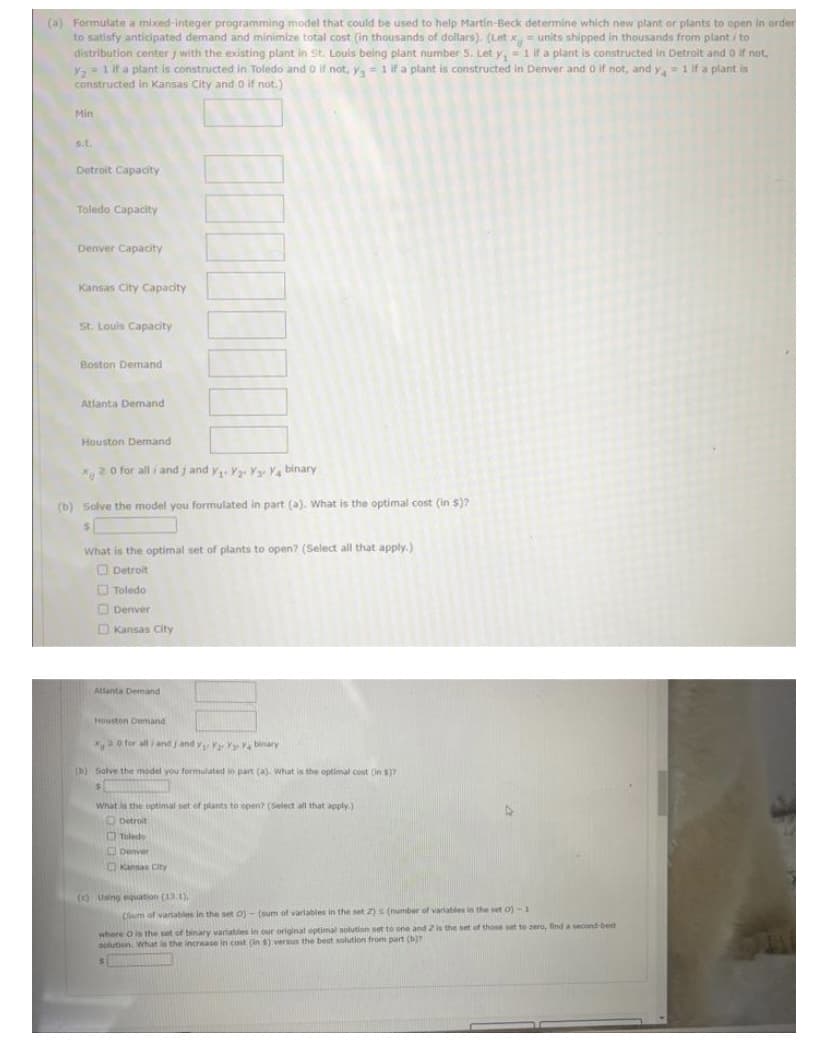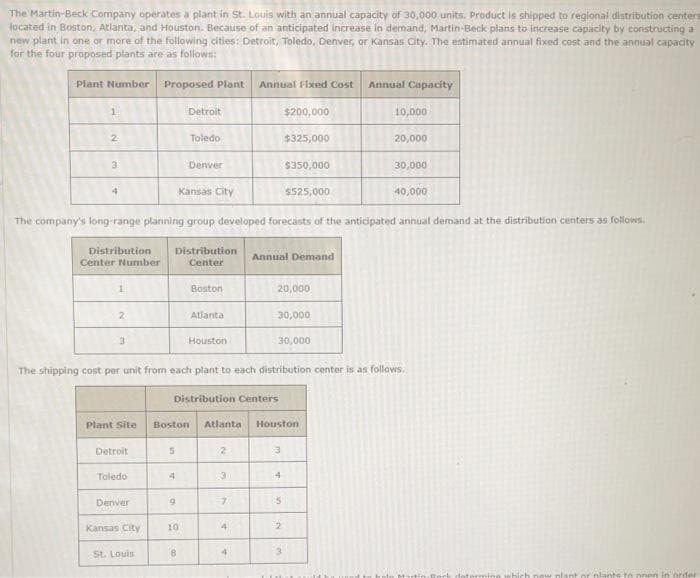The Martin-Beck Company operates a plant in St. Louis with an annual capacity of 30,000 units. Product is shipped to regional distribution center located in Boston, Atlanta, and Houston. Because of an anticipated increase in demand, Martin-Beck plans to increase capacity by constructing a new plant in one or more of the following cities: Detroit, Toledo, Denver, or Kansas City. The estimated annual fixed cost and the annual capacity for the four proposed plants are as follows: Plant Number Proposed Plant Annual Fixed Cost Annual Capacity 1 2 3 4 1 2 3 Plant Site Detroit Toledo Denver Detroit Boston 5 Toledo The company's long-range planning group developed forecasts of the anticipated annual demand at the distribution centers as follows. Distribution Center Number Distribution Center 4 Denver Kansas City 9 Boston Atlanta Houston Distribution Centers 30,000 The shipping cost per unit from each plant to each distribution center is as follows. 2 3 7 $200,000 $325,000 Annual Demand $350,000 20,000 $525,000 30,000 Atlanta Houston 3 4 5 10,000 20,000 30,000 40,000
The Martin-Beck Company operates a plant in St. Louis with an annual capacity of 30,000 units. Product is shipped to regional distribution center located in Boston, Atlanta, and Houston. Because of an anticipated increase in demand, Martin-Beck plans to increase capacity by constructing a new plant in one or more of the following cities: Detroit, Toledo, Denver, or Kansas City. The estimated annual fixed cost and the annual capacity for the four proposed plants are as follows: Plant Number Proposed Plant Annual Fixed Cost Annual Capacity 1 2 3 4 1 2 3 Plant Site Detroit Toledo Denver Detroit Boston 5 Toledo The company's long-range planning group developed forecasts of the anticipated annual demand at the distribution centers as follows. Distribution Center Number Distribution Center 4 Denver Kansas City 9 Boston Atlanta Houston Distribution Centers 30,000 The shipping cost per unit from each plant to each distribution center is as follows. 2 3 7 $200,000 $325,000 Annual Demand $350,000 20,000 $525,000 30,000 Atlanta Houston 3 4 5 10,000 20,000 30,000 40,000
Practical Management Science
6th Edition
ISBN:9781337406659
Author:WINSTON, Wayne L.
Publisher:WINSTON, Wayne L.
Chapter6: Optimization Models With Integer Variables
Section6.5: Set-covering And Location-assignment Models
Problem 34P
Related questions
Question

Transcribed Image Text:(a) Formulate a mixed-integer programming model that could be used to help Martin-Beck determine which new plant or plants to open in order
to satisfy anticipated demand and minimize total cost (in thousands of dollars). (Let x = units shipped in thousands from plant i to
distribution center with the existing plant in St. Louis being plant number 5. Let Y, 1 fa plant is constructed in Detroit and o if not,
Y, = 1 if a plant is constructed in Toledo and o if not, y, =1 if a plant is constructed in Denver and o if not, and y, = 1 if a plant is
constructed in Kansas City and O if not.)
Min
s.t.
Detroit Capadity
Toledo Capacity
Denver Capacity
Kansas City Capacity
St. Louis Capacity
Boston Demand
Atlanta Demand
Houston Demand
20 for all i and j and y, y, Y Y, binary
(b) Solve the model you formulated in part (a). What is the optimal cost (in s)?
What is the optimal set of plants to open? (Select all that apply.)
O Detroit
O Toledo
O Denver
D Kansas City
Attanta Demand
Houston Demand
2o for all i and j and y Y binary
(b) Solve the model you formulated in part (a). what is the optimal cost (in s)?
What is the optimal set of plants to open? (Select all that apply.)
ODetroit
O Toledo
Denver
Kansas City
(9 Uing equation (13.1),
(Sum of varables in the set O) - (sum of varlables in the set 2) (number of variables in the set o) -1
where O is the set of binary variatles in our original optimal solution set to one and 2is the set of those set to zero, find a second best
solution What is the increase in cost (in $) versus the best solution from part (b)

Transcribed Image Text:The Martin-Beck Company operates a plant in St. Louis with an annual capacity of 30,000 units. Product is shipped to regional distribution centers
located in Boston, Atlanta, and Houston. Because of an anticipated increase in demand, Martin-Beck plans to increase capacity by constructing a
new plant in one or more of the following cities: Detroit, Toledo, Denver, or Kansas City. The estimated annual fixed cost and the annual capacity
for the four proposed plants are as follows:
Plant Number
Proposed Plant
Annual Fixed Cost
Annual Capacity
Detroit
$200,000
10,000
2.
Toledo
$325,000
20,000
3.
Denver
$350,000
30,000
4
Kansas City
$525,000
40,000
The company's long-range planning group developed forecasts of the anticipated annual demand at the distribution centers as follows.
Distribution
Distribution
Annual Demand
Center Number
Center
Boston
20,000
2.
Atlanta
30,000
Houston
30,000
The shipping cost per unit from each plant to each distribution center is an follows.
Distribution Centers
Plant Site
Boston
Atlanta
Houston
Detroit
3
Toledo
4
3
4
Denver
Kansas City
10
4
St. Louis
3.
4.
new nlantor nlants to nnen in order
in
1,
Expert Solution
This question has been solved!
Explore an expertly crafted, step-by-step solution for a thorough understanding of key concepts.
This is a popular solution!
Trending now
This is a popular solution!
Step by step
Solved in 5 steps with 9 images

Recommended textbooks for you

Practical Management Science
Operations Management
ISBN:
9781337406659
Author:
WINSTON, Wayne L.
Publisher:
Cengage,

Practical Management Science
Operations Management
ISBN:
9781337406659
Author:
WINSTON, Wayne L.
Publisher:
Cengage,